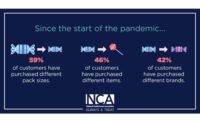Until this year, there were no real reference points for how grocery shoppers would respond to a pandemic. While many looked to the 1918 Flu as the last major health event, it was clear that looking back more than 100 years wasn’t ideal for predicting the future.
Now though, we have a years’ worth of data. And Instacart has recently shared its own data regarding grocery shopping changes over the last year that I never would have imagined having access to even 10 years ago.
The company facilitates online grocery orders by allowing consumers to place an order on the app, and then pairing an independent shopper to collect and usually deliver the items. Because Instacart is set up to operate in various regions, and to allow consumers to order for a variety of stores, their insights offer a uniquely broad view of how things shifted during the pandemic.
Although the data does include the results of a new Instacart survey of 2,038 U.S. adults conducted recently online by The Harris Poll, it also includes shopping data from the app. That means, the industry can see what consumers actually did, rather than what they said they did.
As many following the secretary likely already know, the Harris survey shows that nearly half of all Americans (48 percent) say that they ordered groceries online during the pandemic. But there is so much more to that story.
Instacart’s news release about all this pandemic-related data starts at the beginning.
“On the evening of March 19, 2020, the first stay-at-home order in North America was issued in California, setting off a transformation of many of our 100-year-old grocery shopping habits. One of the most notable shifts proved to be America’s en masse move from in-store shopping to online grocery. Almost overnight, millions signed up for online grocery delivery to get food on the table safely during a difficult time,” the company said. “In a relatively short period of time, the national mood, our relationships, internal clocks, domestic roles, shopping schedules and shopping lists shifted dramatically. In this report, we examine those dynamics and what they may mean for post-pandemic life through the lens of the most universally relatable household task: grocery shopping.”
In early spring 2020, consumers still grappled with the unknown as the frightening reality of the pandemic set in. Instacart/Harris Poll survey data reveals that a surge of sadness, uncertainty, and anxiety washed over consumers as they planned their grocery shopping.
Some survey respondents cited anxiety and fear of COVID-19 as a key motivator for shopping online.
“For the first months of the pandemic, myself and members of my family were afraid of physically going into stores so we utilized the delivery of groceries,” said one respondent, a 24-year-old male from California
And here is where the Instacart data starts to get especially interesting. The company cites its own chat data, referencing conversations consumers had with the shoppers who were picking up their orders.
“This palpable sense of uncertainty was visible in the Instacart marketplace,” the company said. “In March, text chat volume between Instacart customers and their Instacart shoppers increased by a whopping 50 percent. As customers and shoppers texted about adding last-minute items to orders, how to replace out of stock items, and more, we observed several signals for how consumers were feeling.”
But wait, there’s more. Instacart also saw a spike in the use of one particular emoji in those chats.
“Consumer fear and anxiety were very apparent in the Instacart marketplace as stay-at-home orders and product shortages set in — tellingly, the “scream” emoji experienced the largest upswing in chat usage, ballooning to four times its normal usage,” said Laurentia Romaniuk, Instacart’s Trend Expert and Senior Product Manager. “However, feelings of fear and uncertainty were paired with and eventually gave way to an overwhelming sense of gratitude toward the essential shoppers picking and delivering their groceries. Use of the word ‘grateful’ increased across Instacart shopper chats to six times its normal usage and remains much higher than pre-pandemic averages a full twelve months later.”
Across the United States, Instacart saw a 13 percent bump in the use of the phrase “thanks” in customer-shopper chat, with MT, ID, WA, OR, CO, NM, MN, MO and PA expressing thanks the most frequently. Meanwhile, states with the lowest frequency of “thanks” are largely clustered in the Southern states.
“With customer-shopper chat trends showing continued elevated use of phrases and emojis that communicate gratitude, we have reason to believe that consumers will retain a deeper sense of gratitude toward Instacart shoppers — perhaps even permanently,” Instacart said. “We also expect to see a sustained boost in shopper-customer chat, now that customers have spent a year becoming more accustomed to the benefits of communicating directly with their shopper.”
I just wanted to added a quick note here, as someone who has worked in the service industry: Make sure that anytime you find yourself thanking your Instacart shopper, or anyone else on the frontlines of this pandemic, that your "Thanks" is also accompanied by a very large tip, preferably in cash. These are the people who got us through one of the worst years in modern history, and a cash tip is least we can give them.
Shoppers turn to candy for comfort
Next, Instacart offers insights into how consumers shifted their behavior as the months of pandemic life continued. And as many in the confectionery industry already known, many shoppers relied on candy to get through the stressful year.
“As the months marched on and a “new normal” settled in, consumers eagerly embraced the nostalgia, comfort, and joy associated with the holiday season. Homebound consumers began to search online for seasonal comforts — holiday-related searches in 2020 greatly outpaced 2019 numbers,” Instacart said.
Specifically:
- Searches for “Halloween candy” grew by 228 percent year-over-year in 2020.
- Year-over-year searches for “Christmas,” “Christmas sprinkles,” and “Christmas decor” grew by 745 percent, 236 percent, and 622 percent, respectively.
- Searches for “Easter candy” and “plastic Easter eggs” grew by 200 percent and 530 percent respectively year-over-year.
For many, the pandemic had the effect of creating a distorted sense of time, a feeling that likely led to this next piece of data.
Searches for certain holiday items weeks and even months earlier than usual. And, according to the Harris Poll survey data, nearly half of Americans (49 percent) said they had begun planning for the holidays earlier in 2020 than they had in years past.
“Instacart searches for comforting fall favorite ‘pumpkin spice’ started to spike as early as March 16, 2020, a whopping 15 weeks sooner than the seasonal spikes of 2019 and 2018,” Instacart said. “Summer favorites like margarita mixers also trended earlier — 51 percent of 2020 searches for “margarita mix” happened by the first week of June, a nearly 10 percent bump from the year before.
Holiday-related searches followed a similar pattern.
Halloween searches accounted for more than 3 times as much search volume in Sept. 2020, compared to Sept. 2019. While Thanksgiving related searches started earlier than in 2019, volume of searches was steadier than Halloween or Christmas. And 46 percent of 2020 searches for Christmas items happened by the first week of December.
According to the Harris Poll survey data, of the people who indicated that they started their holiday planning earlier this past year, many say it was because it gave them something to look forward to (44 percent), it brought them additional joy when they needed it (35 percent) and that it was a stress reliever (32 percent).
So will holiday planning go back to a normal timeline if we get past COVID-? Instacart doesn’t think so.
“Even as the world returns to normal, we anticipate that 2021 consumer interest in holiday essentials will remain high as people plan for the biggest holiday “do-overs” of their lives,” the company said. “This past year, more consumers than ever turned to Instacart for their holiday essentials, especially in the face of pandemic-driven postal delays. With retail partners like Best Buy, Dick’s Sporting Goods, the Disney Store, and Sephora all joining Instacart in 2020, we expect to see continued growing interest in same-day, non-grocery delivery, whether for gifts or simply for added convenience.”
Pandemic spurs more household members to help with grocery shopping
Instacart also found that the profile of the online grocery consumer changed dramatically in the past year.
Notably, older adults started buying groceries online.
“Social distancing rules and COVID-19’s outsized effect on older adults have greatly affected who’s buying the household’s weekly groceries,” the company said. “Generational insights collected by Instacart reveal that customers over the age of 60 turned to online grocery last spring in record numbers to get their groceries delivered safely and reliably. Between the first and fourth quarter of 2020, we saw a 9 percent increase in the number of seniors using Instacart — the largest jump within any age group. Widespread adoption by seniors led us to develop Instacart’s Senior Support Service, a high-touch support offering designed to help customers over age 60 adopt online grocery during the pandemic. To date, nearly 300,000 seniors have learned how to use Instacart with the help of Instacart’s dedicated senior support specialists.”
In addition, younger generations and other household members also stepped in to share the domestic load.
“According to the Harris Poll survey data, nearly 3 in 4 Americans who were the primary grocery shopper for their household before the COVID-19 pandemic (74 percent) report that someone in their household has taken on additional grocery shopping responsibilities since the start of the pandemic. In general, Gen Z (ages 18–24) and Millennials (ages 25–40) are even more likely than Gen X (ages 41–56) and Boomers (ages 57–75) to say someone in their household has taken on additional grocery shopping responsibilities (89 percent and 85 percent vs. 71 percent and 62 percent).
As one 22-year-old female survey respondent put it, “I didn’t feel comfortable exposing myself when I was staying with my elderly grandparents.”
Instacart said that was a common sentiment seen in text chats between Instacart customers and shoppers. Specifically, in the spring, customer mentions of different family members surged.
Post-pandemic, Instacart expects the profile of the online grocery delivery customer to continue expanding to younger and older customers, many of whom spent the last year discovering the convenience and ease of online grocery delivery.
The company also anticipates that seniors, now that they’ve crossed the digital shopping divide out of necessity, will continue to take advantage of the convenience of Instacart as an easy & accessible way to augment in-store visits.
“Even today as the world slowly starts to open up and more seniors are eligible for vaccines, we continue to see a steady rise in seniors coming online via our Senior Support Service, which has been growing by about 1,000 senior customers daily,” the company said.
They also expect to see expanded use cases for Instacart now that the pandemic has opened consumers’ eyes to new applications of online grocery delivery, like helping loved ones with grocery shopping from a distance, sending gifts to friends and family, keeping a dorm room stocked with study snacks, or involving older children in meal planning.
Grocery shopping shifts to mid-week activity
Fascinatingly, consumers also shifted which day of the week they were buying groceries on.
“Instacart data indicates that the weekly 90-minute Sunday shop may be loosening its grip on our weekend routines,” the company said. “After an upheaval in our daily routines and (for some) a shift toward more flexible work arrangements, customers have been placing a larger share of their orders earlier in the day and on weekdays, a trend that has continued into 2021
The share of orders placed on weekdays grew by 8 percent platform-wide last year. And Instacart orders placed during local working hours (9 a.m. to 5 p.m.) increased by 32 percent in 2020.
“Early 2021 analysis shows us that while some consumers have returned to their weekend ordering habits, a meaningful portion of others are holding onto their new midweek routine,” Instacart said. “Many Harris Poll survey respondents cited the convenience of grocery platforms as a key motivator to continue.”
Romaniuk explains that online grocery shopping fits seamlessly into the more flexible schedules that the world is moving toward after a collective awakening to the benefits of remote work. And Romaniuk expects this trend to linger after COVID-19 as well.
“Given the trends we’re seeing, we expect many consumers to stick with their new mid-week grocery delivery routines, now that they’ve experienced the flexibility that online platforms like Instacart give them to build and maintain shopping lists throughout the week and easily place an order in between meetings and personal time, to be delivered in as fast as two hours,” she explains.
Post pandemic: The future of grocery is fast
While consumer shopping habits will continue to evolve as the world inches closer to “normal,” living through more than a year of distanced living, new habits and cultural norms have forever changed how many of us shop. Instacart went from a convenience to a lifeline and has now become a fixture in people’s lives.
According to the Harris Poll data of those who bought groceries online during the pandemic, 77 percent indicated they are likely to continue doing so in the future.
Importantly, the past year has also given millions of consumers a taste for the speed and convenience of online grocery, and Instacart data reveals that consumers are hungry for more. Gone are the days of two-day delivery; customers now expect to get their groceries in as fast as two hours — if not much faster.
In an Instacart experiment, when presented with a slate of delivery options including 2-hour or less delivery, 5-hour delivery, and other scheduled options throughout the day, an overwhelming 85 percent of customers opt for delivery in 2 hours or less.
Further, when Instacart looks at smaller grocery orders of 15 items or fewer, customers have an even greater expectation to get their deliveries ASAP.
In the end there, all this data can be quite useful to the candy companies willing to respond to it. The world has indeed changed in the last year. The companies that succeed must change with it.
For all the Instacart insights the company shared, as well as graphs depicting trends, check out the full news release on the Instacart website.





